When we’re on long road trips, rest stops are crucial for giving us a moment to stretch, refresh, and regroup before hitting the road again. But it’s important to be aware and cautious during these breaks to ensure our safety and that of our possessions. In our article, “Staying Safe at Rest Stops: Essential January Tailor: All My Husbands Tips,” we share practical advice on how to stay safe at rest stops. From being mindful of where we park to understanding the best times to stop, we cover all you need to know to protect yourself, your fellow travelers, and your belongings during these necessary pauses in your journey. Have you ever wondered about how safe you really are when you pull over at a rest stop during a long drive? We’ve all been there—needing a break after hours on the road, searching for a moment of respite or a quick snack, perhaps with kids or pets in tow. But not all rest stops are created equal in terms of safety and amenities. That’s why we’re sharing some essential tips on how to stay safe at rest stops. Let’s dive in and ensure that each pit stop is as secure as it is refreshing.

Understanding Rest Stops
Rest stops, also known as rest areas, are designated places along highways where drivers can stop to rest, refresh, and refuel—both themselves and their vehicles. But before we discuss how to stay safe at these stops, let’s understand the different types that you might encounter.
Types of Rest Stops
Generally, rest stops fall into two categories: government-operated public rest areas and privately-owned service areas. Public rest areas are typically basic, offering parking, restrooms, picnic tables, and sometimes vending machines. Privately-owned service areas, on the other hand, might resemble small shopping centers, featuring food courts, gas stations, and sometimes even retail outlets.
Locations and Frequencies
The location and frequency of rest stops can vary widely from state to state in the U.S. Some states pride themselves on well-maintained, frequent rest areas, while others may have less frequent facilities. The spacing often depends on the infrastructure funding and policies of each state.
Preparing for a Rest Stop
Before pulling into any rest stop, there are a few things we should always consider to ensure our stop is as safe as possible.
Checking Reviews and Ratings
It’s a good idea to check reviews and ratings of rest stops before making a stop. Websites and apps like Google Maps and Yelp can provide insights from other travelers about cleanliness, safety, and amenities. This little bit of research can go a long ways.
Planning Your Stops
Use your GPS or a map to identify rest stops along your route. We recommend planning your stops in advance, especially if you’re traveling late at night or with family. Knowing exactly where you’re going to stop can help mitigate any risks and reduce the need for unexpected stops in unfamiliar places.
Safety Tips at Rest Stops
Staying safe at rest stops is crucial, and there are several ways to approach this. Here’s how we can ensure our safety and that of our belongings.
General Safety Tips
Park in Well-Lit Areas
Always try to park in areas that are well-lit. This increases visibility and may deter potential criminals. If the lighting at the rest stop isn’t adequate, consider moving on to another or parking as close as possible to the rest area building or to other families.
Lock Your Doors
Right after parking, ensure that all your vehicle doors are locked. This is a simple step but essential for keeping everyone and everything inside the vehicle safe.
Be Aware of Your Surroundings
Remain observant of your surroundings. If something doesn’t feel right, trust your instincts—it’s better to be cautious.
Safety Tips for Families
Monitor Children
Keep children in sight at all times. Rest stops can be crowded and confusing for a child, making it easy for them to get lost.
Educate Your Family
Before any trip, discuss with your family the importance of sticking together and caution them about talking to strangers or wandering off alone.
Safety Tips for Night Stops
Avoid Stopping Alone
If possible, try not only to travel with companions but also to take your breaks at the same time as other travelers. There is often safety in numbers.
Use Front-Facing Parking
When parking at night, choose spots that face the exit or are along the main thoroughfare within the rest stop. Avoid secluded corners.
Protecting Your Belongables
Rest stops, while necessary, can sometimes be hotspots for petty theft. Here’s how we can keep our belongings safe.
Keep Valuables Out of Sight
Before leaving your car, make sure that any valuables are either taken with you or hidden. A visible phone, wallet, or even shopping bags can be tempting to thieves.
Use Secure Storage
If your vehicle has a trunk, use it. Storing items out of sight can help prevent break-ins and provides an extra layer of security.
Consider Anti-Thefty Technology
There are various anti-theft gadgets—from steering wheel locks to alarm systems—that can add an extra layer of security to your vehicle while you’re away from it.

Managing Health and Hygiene
Rest stops are used by thousands of travelers, which means we need to be mindful of health and hygiene, especially in common areas like bathrooms and picnic spots.
Use Hand Sanitizer
Always keep hand sanitizer handy and use it before and after using public facilities. This can help reduce the risk of transmitting germs and keep you and your family healthy.
Bring Your Own Supplies
Consider…


